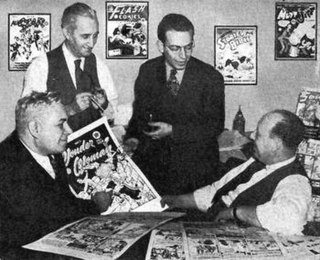
Maxwell Charles Gaines was an American publisher and a pioneering figure in the creation of the modern comic book.
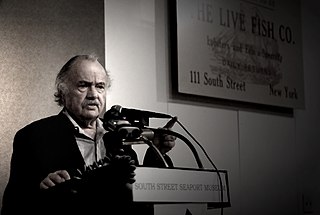
Ronald Joseph Goulart (; was an American popular culture historian and mystery, fantasy and science fiction author.

An American comic book is a thin periodical originating in the United States, on average 32 pages, containing comics. While the form originated in 1933, American comic books first gained popularity after the 1938 publication of Action Comics, which included the debut of the superhero Superman. This was followed by a superhero boom that lasted until the end of World War II. After the war, while superheroes were marginalized, the comic book industry rapidly expanded and genres such as horror, crime, science fiction and romance became popular. The 1950s saw a gradual decline, due to a shift away from print media in the wake of television and the impact of the Comics Code Authority. The late 1950s and the 1960s saw a superhero revival and superheroes remained the dominant character archetype throughout the late 20th century into the 21st century.

Hi and Lois is an American comic strip about a suburban family. Created by Mort Walker and illustrated by Dik Browne, both of whose children currently work on the strip, it debuted on October 18, 1954, distributed by King Features Syndicate.
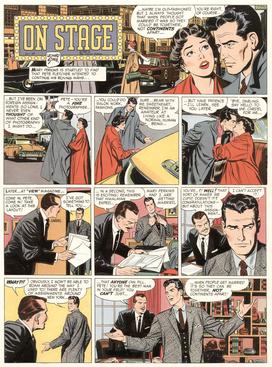
Mary Perkins, On Stage is an American newspaper comic strip by Leonard Starr for the Chicago Tribune-New York News Syndicate. It ran from February 10, 1957, to September 9, 1979, with the switch to the longer title in 1961. Some papers carried the strip under the shortened title Mary Perkins.

Scorchy Smith is an American adventure comic strip created by artist John Terry that ran from March 17, 1930 to December 30, 1961.

The Funnies is the name of two American publications from Dell Publishing, the first of these a seminal 1920s precursor of comic books, and the second a standard 1930s comic book.

Major Malcolm Wheeler-Nicholson was an American pulp magazine writer and entrepreneur who pioneered the American comic book, publishing the first such periodical consisting solely of original material rather than reprints of newspaper comic strips. Historian and author David Hajdu credits Wheeler-Nicholson as "the link between the pulps and what we know of as comics today." He launched the magazine comics company National Allied Publications in 1935, which would evolve to become DC Comics, one of the United States' two largest comic book publishers along with rival Marvel Comics. He was a 2008 Judges' Choice inductee into the Will Eisner Comic Book Hall of Fame.

Funnies on Parade is an American giveaway publication of 1933 that was a precursor of comic books. The eight-page publication featured reprints of such popular syndicated comic strips as The Bungle Family, Joe Palooka, Keeping Up with the Joneses, Mutt and Jeff, Reg'lar Fellers, and Somebody's Stenog. Creators included F. O. Alexander, Gene Byrnes, Al Capp, Clare Victor Dwiggins, A. E. Hayward, C. M. Payne, Al Smith, and Harry J. Tuthill.
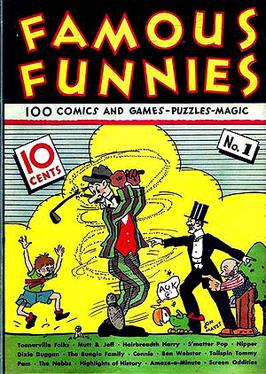
Famous Funnies is an American comic strip anthology series published from 1934 to 1955 with two precursor one-shots appearing in 1933–1934. Published by Eastern Color Printing, Famous Funnies is considered by popular culture historians as the first true American comic book, following seminal precursors.
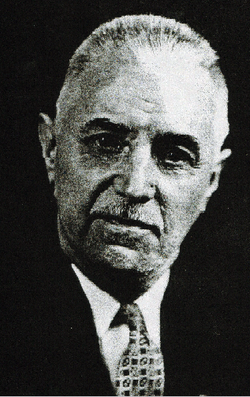
Melville Porter Cummin, popularly known as Mel Cummin, was a magazine illustrator and a newspaper staff artist; a notable cartoonist in the early decades of American comic strips; and a Golden Age comic book artist and art director. He was active in the Society of Friends. Cummin was also a well-known naturalist and explorer.
Baron Bean is a newspaper comic strip created by the cartoonist George Herriman. Baron Bean was distributed by King Features Syndicate.
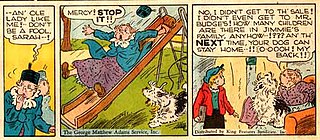
Cap Stubbs and Tippie is a syndicated newspaper comic strip created by the cartoonist Edwina Dumm that ran for 48 years, from August 21, 1918, to September 3, 1966. At times the title changed to Tippie & Cap Stubbs or Tippie.

William Marien Conselman was an American screenwriter who also wrote newspaper comic strips under his Bill Conselman byline and sometimes under the pseudonym Frank Smiley.
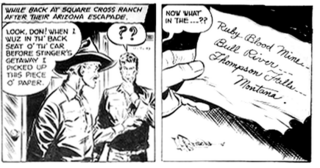
Don Winslow of the Navy is an American comic strip created by Frank Victor Martinek and was distributed mostly by the Bell Syndicate from 1934 to 1955. The title character was a spy-chasing lieutenant commander in Naval intelligence. The comic strip led to a radio adventure serial that began in 1937, as well as film serials that began in 1942. Original comic book stories also appeared in Fawcett Comics titles starting in 1943.

Frank Henry Willard was an American cartoonist best known for his syndicated newspaper comic strip Moon Mullins which ran from 1923 to 1991, working alongside assistant Ferd Johnson. He sometimes went by the nickname Dok Willard.
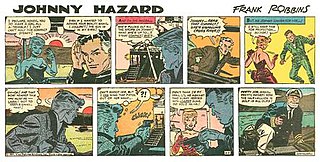
Johnny Hazard is an action-adventure comic strip created by cartoonist Frank Robbins for King Features Syndicate. It was published from June 5, 1944, until August 20, 1977, with separate storylines for the daily strip and the Sunday strip.
The Bell Syndicate, launched in 1916 by editor-publisher John Neville Wheeler, was an American syndicate that distributed columns, fiction, feature articles and comic strips to newspapers for decades. It was located in New York City at 247 West 43rd Street and later at 229 West 43rd Street. It also reprinted comic strips in book form.
Associated Newspapers, Inc. was a print syndication service of columns and comic strips that was in operation from 1912 to c. 1966. The syndicate was originally a cooperative of four newspapers: The New York Globe, the Chicago Daily News, The Boston Globe, and the Philadelphia Bulletin. Associated Newspapers was led by Henry Herbert McClure (1874-1938), a cousin of S. S. McClure, founder of the McClure Syndicate, the first American newspaper syndicate. In 1930, Associated Newspapers was acquired by and became a subsidiary of the Bell Syndicate. The syndicate's most successful, long-running strip was Gladys Parker's Mopsy.
Metropolitan Newspaper Service (MNS) was a syndication service based in New York City that operated from 1919 to 1932. At first the syndication service of Metropolitan Magazine, it soon became affiliated with the Bell Syndicate, and then was acquired and absorbed into United Feature Syndicate.
















